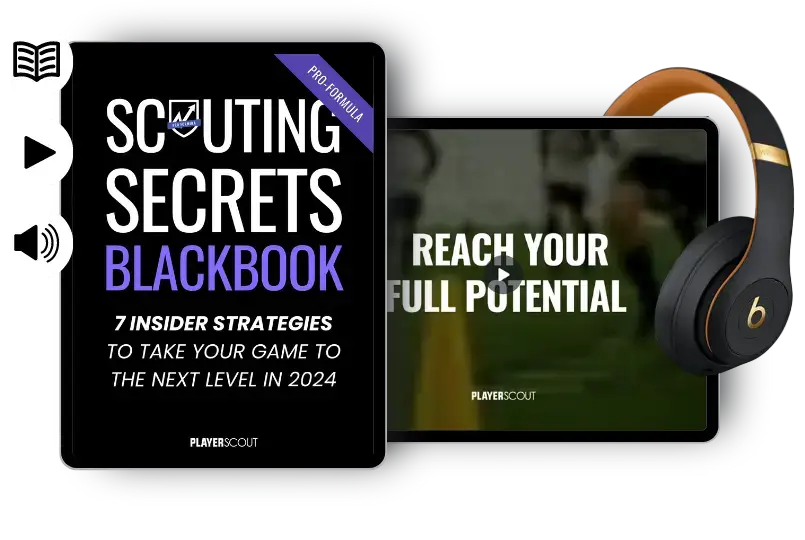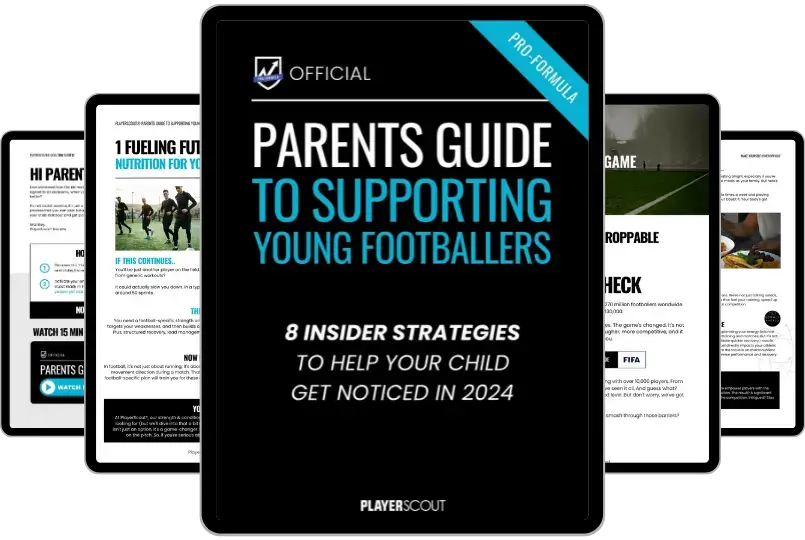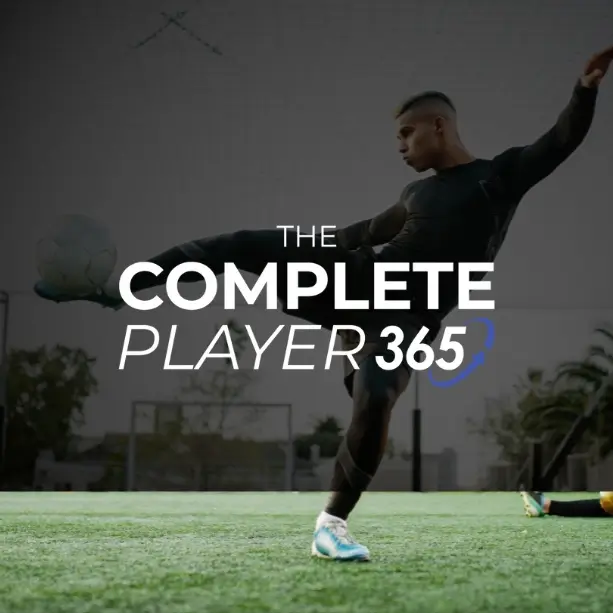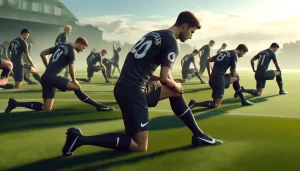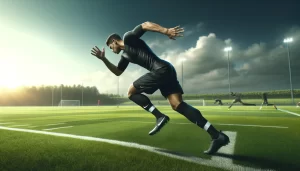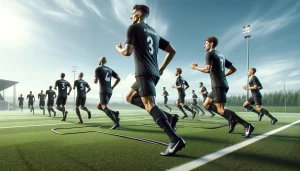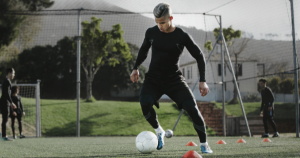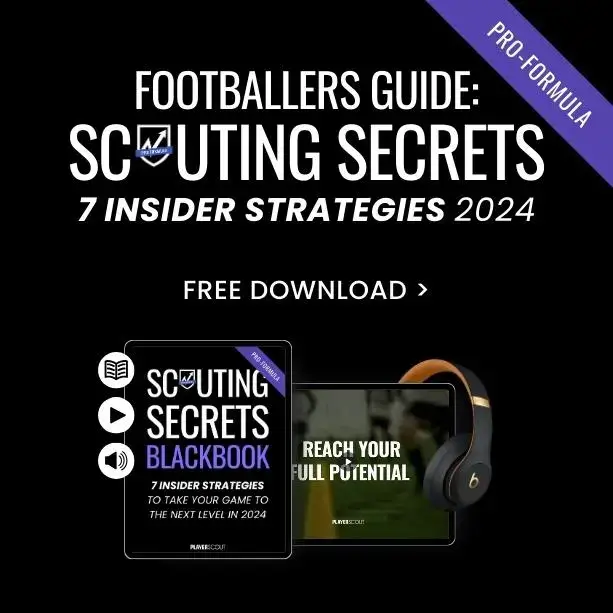World Football Rules
FIFA (the governing body of world football) update the rules of football rules each season. For a more in-depth (144 Pages) version of the rules of football check out FIFA’s The Laws of the game. These are an adaptation of the English Football Association laws of the game created in 1863. Below we have simplified the 17 laws of the game, so you can gain a basic understanding of the rules.What is Football?
Law 1: The Field Of Play
Football matches take place on natural or artificial grass/turf. The surface must be rectangular in shape and green in colour.
The rectangle comprises two longer boundary (touchlines) and two shorter (goal lines). The pitch is the split into two halves, with the midpoint called the halfway line.
Football Field Dimensions
The Touch Line (length of field): Min 90m – max 120m Width The Goal Line (width of field): Min 45m – max 90m The painted lines width is maximum 12cm and all lines must be the same width.International Football Field Dimensions
The dimensions differ for international matches where the following field measurements apply: Touch line: Min 100m- max 110m Goal Line: Min 64m – max 75m The following areas must painted on the pitch:- The Goal Area
- The Penalty Area
- Flag posts
- The Corner Arc
- Goals: Can be square, round or elliptical in shape and made of wood, metal or other approved material. The height from lower edge of crossbar to the ground is 2.44 meters and 7.32 meters post to post.
Law 2 - The Ball
The ball is spherical in shape and must be leather. It must weigh between 410g – 450g at the start of the match and have a circumference of 68cm – 70 cm.
The ball pressure must be equal to 0.6 -1.1 atmosphere at sea level.
If the ball bursts the referee will stop the match and restart with a drop ball (with new ball).
Law 3 - The Number Of Players
A football match consists of two opposing teams of 11 players. The game cannot start or continue if one team has less than 7 players.
Teams can use up to 3 substitutes throughout the game. But some international friendly fixtures may allow up to 6 substitutes
Once substituted, a player cannot return onto the pitch.
Law 4 - The Players' Equipment
Players must not wear jewellery or any items dangerous to themselves self or others.
Basic Compulsory Equipment include:
- A shirt or jersey
- Shorts – undershorts or compression tights must be the same colour as shorts/li>
- Socks – any tape must be the same colour as sock/li>
- Shinguards/li>
- Footwear (football boots)/li>
Goalkeepers must wear distinguishable colours from the other players and referee’s kits.
Law 5 - The Referee
The head referee enforces the laws of the game. They have full authority and their decision is final. Therefore it is against the rules for players or management to challenge decisions.
Referees are responsible for:
- Inspecting and ensuring all players have the correct kit and equipment
- Keeping time
- Signalling kick offs and end of game (and any restarts in play)
- Punishing any rule violations
- Any stoppage of play due to injuries or weather
- Deciding if a game can continue or not
A referee has a set of yellow and red cards. A yellow card is given to prevent repeated rule breaking or unsportsmanlike behavior. If a player receives two yellow cards, this is equal to a red card, and they are sent from the field and cannot return.
Law 6 - The Other Match Officials
- when the ball leaves the field of play
- by highlighting which team is entitled to a goal kick, throw in or corner kick
- by flagging if a player is offside
- when incidents happens out of the head referees view
- if a team request a substitute
- by judging if the ball crosses the line at a penalty kick. Or if the keeper steps off his line before the player kicks the ball
Law 7 - The Duration of the Match
A football match duration is two equal half’s of 45 minutes. The half time interval must not exceed 15 minutes.
The referee may add on extra time for:
- any substitutions
- a player injury assessment
- time wasting
- any injured player who has to taken from the field
Added time will be played at the end of the half to make up for any time lost during the game. This is known as ‘injury time’ and is different to the ‘extra time’ in knockout tournaments that decide the winner.
Law 8 - The Start and Restart of Play
The game starts and restarts with a kick off. This takes place:
- when the match starts
- after any goal is scored
- to begin the second half
- at the beginning of any extra time or second half of extra time
New rules state that the ball no longer has to go forward from kick off. Players can now pass back to anyone on their team even shoot straight at goal.
A coin toss decides which team kick off first. The coin toss winner chooses the end to attack, whilst the loser kicks off.
Both teams change ends at half time, with the team who won the toss kicking off. All players must be in their own half before the kick off.
A team will restart the game with a kick-off if they concede a goal.
Law 9 - Ball In and Out of Play
The ball is out of play when the whole ball crossing the goal line or touch line (in the air or on the ground). Besides these times, the ball is in play.
Law 10 - Determining the Outcome of a Match
A team scores a goal when the ball crosses the goal line, inside the posts and crossbar. The goal will only count provided no other rule violations have taken place.
The winning team is the team who score the most goals. If both teams are level at the final whistle, then the match is a draw. (Unless in a competition where extra time, away goals and penalties coming in play).
Goal Line Technology signals whether the whole ball has crossed the goal line. A message is sent to the referee to highlight a goal or no goal.
Law 11 - The Offside Rule
- in his own half
- level with the second last opponent
- receiving the ball from a goal kick, throw-in or corner kick
- a free kick is given to the opposing team when a referee believes a player is offside
Law 12 - Fouls and Misconduct
Football is a contact sport. However, excessive force, reckless behaviour or handling the ball results in a free-kick.
The most common fouls and misconduct in football are:
- kicking, tripping or attempting to kick or trip an opponent
- charging an opponent
- striking or pushing an opponent
- spitting at an opponent
- holding an opponent
- deliberate handball (except for the goalkeeper in his own area)
Penalty kicks are awarded if any of the above fouls take place in the penalty area, as long as the ball is in play.
An indirect free kick is given when a goalkeeper:
- holds the ball in hands in his own area for over 6 seconds
- uses his hands after a teammate passes the ball to him
- touches the ball with hands after releasing it and before another player touches it
- handles the ball from a thrown in taken by a teammate
The referee will award an indirect free kick if he believes an outfield player:
- is playing in a dangerous manner
- impedes an opponent
- is preventing the opposing goalkeeper from releasing the ball
Law 13 - Free Kicks
If a foul or infringement takes place, play resumes with a direct or indirect free kick.
Direct Free Kick:
A player can score from a direct free kick with no other player touching the ball. But, if the player kicks a direct free kick into his own goal, the opposing team get a corner kick.
Indirect Free Kick:
When a ref awards an indirect free kick he will raise one arm above his head until the free kick is struck
The ball must touch another player before crossing the opposing team’s goal line for a goal to stand.
If an indirect free kick goes into the goal directly, a goal kick is awarded. If an indirect free kick is kicked into a players own goal, a corner kick is awarded to the opposing team.
The ball must be stationary for all free kicks and corners.
Law 14 - The Penalty Kick
Law 15 - The Throw In
A throw-in is another way to restart the match when the whole ball crosses either touch lines. The throw is given to the opposing team of the player who touch the ball last.
The throw-in must be taken from the exact spot the ball left the field of play. Players cannot score directly from a thrown in.
The player taking the throw- in must have both feet behind the touch line (off of the pitch). Holding the ball in both hands, the player must deliver the ball from behind his head.
Law 16 - The Goal Kick
If the whole of the ball crosses the goal line after touching an attacking player last, a goal kick is given.
The game restarts by the goalkeeper kicking the ball out of his penalty box from within his goal area. The ball must touch another player before the goalie can touch the ball again.
All opposing players must remain outside the penalty area until the goal kick is taken.


